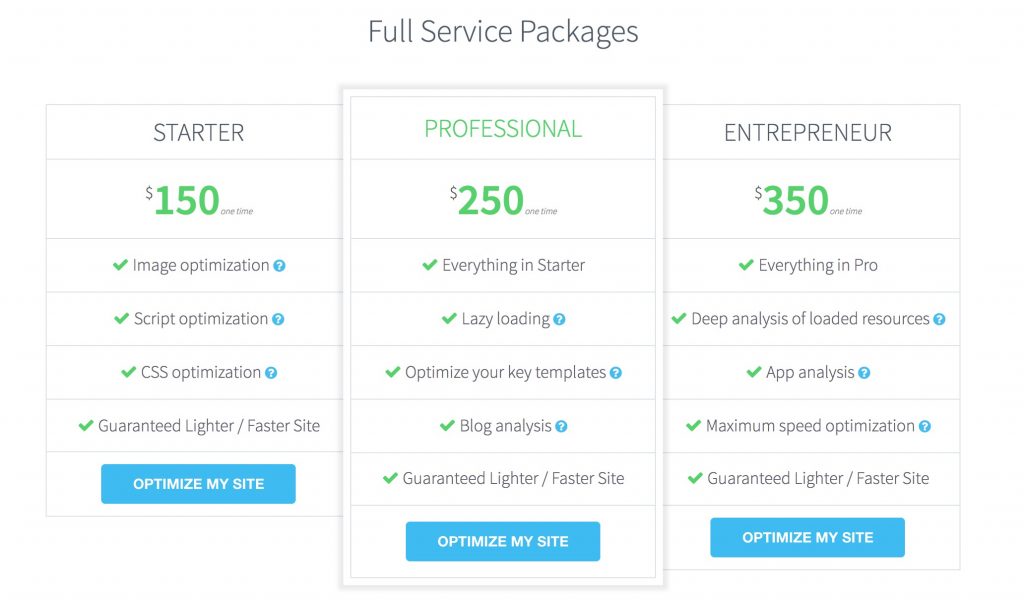Oh hey first did you hear, Speed Boostr is turning 1 year old in October. Nice!
What started as a side project to dive into the depths of performance and optimize Shopify turned into… a growing collective of Shopify developers working to make Shopify sites (and the web in general) faster.
Speed Boostr 1.0
We used to only offer packages like this:

The features/services have changed a couple times, this is a snapshot of it today in September 2018.
This model works great for a lot of sites, in fact here’s a screenshot of the average improvements on our last 50 customers:

Note the testing parameters are on LTE 12Mbs down, a kind of average “mobile speed”. This is for consistent benchmarking, speeds will vary depending on internet connection speed.
The key factor is page weight reduction. Speed is the overall goal, but depends on the device, connection speed, tool used to measure, server that ran the test, etc… so it’s variable. But if you reduce your page weight, there is less actual data to transfer, so your site will be faster.
Those summary stats don’t include outliers – the sites that were suuuuuper slow where we were able to increase load speed by over 10 seconds, or make crazy drops in page weight. Usually some errors or faulty apps can cause these problems, or lots of huge images… either way it’s one of the perks of working with us, we analyze to uncover your site’s problems.
Even then, set packages aren’t a perfect solution. Yes 99% of sites will be improved by purchasing one of our service packages, but here are 3 scenarios where a full package isn’t the best solution:
1) Some people have already done a decent amount of optimizations, but need help on points they’re not familiar with – maybe you optimized your images and CSS, but aren’t sure how to analyze your server requests. In this cases, a general optimization isn’t needed, but instead you’d want help on focused areas.
2) A Shopify store owner found a tool like PageSpeed Insights, Pingdom, etc. that identifies potential performance issues and wants specific issues fixed.
3) The package prices are out of budget, and you’d like to start smaller. Performance optimization improves many key metrics, which translates to generating a positive ROI at some point (the exact timeline is difficult to gauge), so it should be done, but maybe you’re not comfortable spending on a full Entrepreneur package just yet.
Speed Boostr 2.0
Over the course of the year we’ve come across new challenges and identified new “features” / ways we can make Shopify sites faster.
We’ve evolved our services, and with your feedback decided to give you more flexibility.
With the end goal always being to improve Shopify site’s performance, no matter the store size or previous optimization work, we now offer more flexibility for the scenarios above and are not just sticking to 3 set packages any more.
Now when you connect with us, we have more options and flexibility for any size store, and we encourage you to use analysis tools to see where your site stands and what needs to be fixed.
We still offer general optimization packages, but instead of the home page focus they now rest on their own Optimization Packages page.
You can head to our Home Page to see the new flow – instead of having to buy a package, you can contact us first to see what would work best for your site.
Analysis Tools
Each dev has their preferences on which tool(s) to use, but any of these will help you identify your site’s potential optimizations and issues:
- Google PageSpeed Insights – the classic, but misleading scoring system and not the best for working with Shopify sites.
- Yellow Lab Tools – my new favorite for spotting potential issues.
- Pingdom – my go-to for seeing the general picture of a site and investigating the “waterfall” (the order of files loaded on a page).
- WebPageTest – more technical, and the most accurate gauge of speed we’ve found.
- GTMetrix – another common tool available in the mix.
If you’re into the technical details, you can pull up your site in any of those tools and ask us for a custom quote to solve specific issues they report.
Some can be solved, some cannot. Some are a compromise, some are clear technical issues.
Caveat on analysis tools like these – I’ve never seen a Shopify site that’s able to have a perfect score. Especially Google PageSpeed Insights, where even Amazon.com has a “poor” score.
Even if you could have a perfect score (if you had access to all the server configurations), it’s usually a balance between choosing usability and revenue generating features vs completely leaning out your site.
These tools are meant to help quickly identify potential problems and opportunities, not an actual indicator of your site’s speed and even “score”.
Don’t stress about a perfect score, rather, use these tools to identify things that can be fixed and improved.
How to Optimize Your Site
Click through on those tools above, see what you’re working with, and take a crack at fixing some warnings… orrrrrr save your time and contact us. We’re happy to help.


Leave A Comment